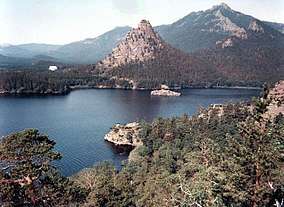Burabay National Park
The Burabay National Park (Kazakh: «Бурабай» мемлекеттік ұлттық табиғи паркі, «Býrabaı» memlekettik ulttyq tabiǵi parki) is a natural park located in the Burabay District, in Aqmola Region, Kazakhstan.
| Burabay National Park | |
|---|---|
IUCN category II (national park) | |
 | |
 | |
| Location | Aqmola Region, Kazakhstan |
| Nearest city | Shchuchinsk, Kokshetau |
| Coordinates | 53°05′00″N 70°18′00″E |
| Area | 83,511 hectares (206,360 acres) |
| Established | 2000 |
| Governing body | Under the responsibility of the President of Kazakhstan |
The park is under the direct jurisdiction of the President of Kazakhstan.
In the protected area of the national park, economic and leisure activities are prohibitted, as the park is under regulation of nature reserves.
History of status
The first step towards the protection of this natural space has been the establishment of the State Forest in 1898. In 1920, Burabay has been nationalized and declared spa town of national importance. In 1935, the « National Nature Reserve of Burabay» has been organized. In 1951, the nature reserve was dissolved, and in place of it, the Burabay Forest has been established. The governmental motion N° 787 of May 6 of 1997 transformed the Forest of Burabay into the « Natural and Well-being Complex of the Forest of Burabay », managed by the State. In 2000, the motion N°1246 of August 12 created the « National nature park of Burabay », which includes a superficy of 83 511 ha, of which 47 600 ha of forests. In 2010, the superficy of the park has been expanded to 129 935 ha. In 2012, 370 ha have been converted in spare lands.[1]
Climate
The climate of Burabay is Humid continental climate, warm summer (Köppen climate classification (Dfb)). This climate is characterized by large seasonal temperature differentials and a warm summer (at least four months averaging over 10 °C (50 °F), but no month averaging over 22 °C (72 °F).[2][3] The average temperature in the park in January is -16 °C, and +19 °C in July.[4] Precipitation average is around 300 mm yearly. In winter, snow cover is around 25–35 cm thick, and lasts from mid-November to April.[5]
Flora and fauna
The park counts 757 sorts of plants,[6] of which 119 should be protected, and 12 are registered in the Red Book. The forest has 65% of pines, 31% of birches, 3% of aspens and 1% of shrubs. Many species of edible mushrooms can be found.[7]
Due to the diversity of the flora, the fauna is very abundant: 305 species of animals can be found,[6] which represents 36% of the fauna diversity of Kazakhstan. 40% of them live at the border of their habitat, and 13 species are registered in the Red Book.
The wildlife of Burabay is much richer than that of the surrounding steppes. There species from steppes, forests and mountains mix. Some Europe-wide species are found as well as Siberian, Southern and Northern ones.
Currently, Burabay's forests host a variety of deer including roe deer, moose, wild boar, squirrels, stoats, weasel and marten. Amongst the predators, wolves and lynx might be encountered. In the steppes and wooded areas, fox species, weasels and European and mountain hares might be met with, as well as badgers in the forests.
There are a variety of birds, particularly ducks and waders which include common goldeneye, mallard, gadwall, northern pintail, ruddy shelducks, plovers, northern lapwings, common sandpipers, green sandpipers. Ducks numbers rise massively during Autumn and during migration periods.
In the dry stony pine forests, and along the forests, the birch wooden steppes, the grey partridge and the capercailie can be found.
Legend
Many legends evoke Burabay. One of them explains that the Creator only left arid steppes to the nomads of Kazakhstan. Feeling aggrieved, Kazakh people prayed God, who gathered all the remaining mountains, forests, lakes and rivers, and threw them towards the steppes. And in this way Burabay was born, and it has been called up to nowadays the «Kazakhstan's pearl».[8]
Gallery
References and links
| Wikivoyage has a travel guide for Burabay National Park. |
References
- History of Burabay's status Archived 2015-11-19 at the Wayback Machine on the official website. (Russian)
- Kottek, M., J. Grieser, C. Beck, B. Rudolf, and F. Rubel, 2006. "World Map of Koppen-Geiger Climate Classification Updated" (PDF). Gebrüder Borntraeger 2006. Retrieved September 14, 2019.CS1 maint: multiple names: authors list (link)
- "Dataset - Koppen climate classifications". World Bank. Retrieved September 14, 2019.
- Burabay National Natural Park- the perl of Kazakhstan, on Kazakhstan Wonders, March 29, 2010;
- Climate characteristics and its influence on the ecosystem Archived 2015-11-24 at the Wayback Machine, official site. (Russian)
- State National Park "Burabai" Archived 2016-03-04 at the Wayback Machine, welcome to Kazakhstan.
- Mushrooms Archived 2015-11-23 at the Wayback Machine, official site. (Russian)
- Burabay (Borovoe) National Nature Park , on orexca.







